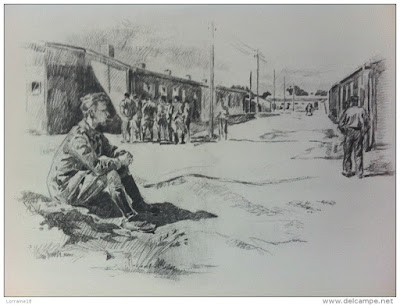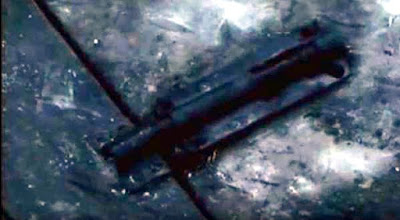 |
| British POWs in Colditz at Christmas - IWM |
Autumn approached in Colditz, and with it came the twilight of the escaping season in 1941. For most POW camps in occupied Europe, the freezing and severe winter weather would curtail or postpone much of the escape work. But the men in Colditz would try anything at any time. They continued their plans with a steady flow of attempts which kept the Germans busy.
On 1 September 1941 Major William Anderson, Squadron Leader Brian Paddon and Lieutenant-Colonel Guy German were discovered by pure chance reconnoitring escape possibilities in the camp kitchen basement area. Whilst they were in situ, a snap fire-fighting practice had been called by Colditz Lieutenant Paul Priem and the courtyard was cleared. A horse drawn fire appliance ‘rushed’ into action through the main doors, followed by a manually pulled contrivance which rattled in to a chorus of ridicule from the POWS looking out from their upstairs windows. As part of the drill, a main hose was passed through the kitchen window to connect with a fire hydrant. The three POWs were discovered. Chance detection at any level of an escape could occur by sheer bad luck and timing.
 |
| Major William Anderson |
 |
| Lieutenant- Colonel Guy German |
On 7 October Lieutenant H Desjobert climbed over a fence on the POWs return walk from the park. Sentries opened fire and closed in. With no chance of getting away he put his hands up and surrendered. The Frenchman was lucky not to have been wounded or killed. During his spell of solitary punishment, Desjobert would gather his thoughts and think about trying again.
Other escape attempts from the park enclosure would have encouraged Belgian Lieutenants Marcel Leroy and Andre Lejeune. On 8 November, they climbed the wire of the ‘sheep pen’ exercise area and made a run up the steep hill towards the park perimeter wall. Rifle shots fizzed past the POWs. As they raced towards the wall, the rounded shape of the cordon meant that sentries risked firing and hitting each other. Bullets were flying at the two Belgians from all directions and guards around the castle walls joined in. The POWs tried to distract the castle guards by shouting abuse from their windows and ‘goon baiting’. This only inflamed the situation. When the Belgians were forced to surrender because they were unable to climb the wall, the guards in the castle had started firing up at the POW windows.
 |
| Park grounds and wall - virtualcolditz.com |
A subsequent enquiry into the incident by Camp Kommandant Oberstleutenant Max Schmidt concluded:
‘There were what appeared to be shots from the French quarters which later turned out to be artificially created, complete with smoke. At the same time, paper darts were thrown at the guards and a steel helmet* appeared at the window. It was very clear that the purpose of the demonstration was to distract the attention of the guards.’
*Tin hat was made of cardboard
A union Jack was also hung out of one of the British windows. Anyone poking their head up during the height of the incident risked getting it blown off.
 |
| Kommandant Oberstleutenant Max Schmidt - war 44.com |
With only 33 POW days to Christmas; a spate of opportunist escape attempts took place:
22 Nov 41 – Lieutenant Geoffrey Wardle and Dutch 2nd Lieutenant H G Donkers were caught attempting to exit through Oberstabsfeldwebel Gephard’s office.
23 Nov 41 - Captain Cyril Lewthwaite was spotted and apprehended in the Polish orderlies’ quarters.
23 Nov 41 – RAF Flight Lieutenant Don Donaldson and Flying Officer Don Thom decided to try their luck over the roof just before it was dark. The sentry on duty at the teatime appell had a predictable routine and the British had noted this before. He would be patrolling the prisoner yard during the evening. Hauptmann Roland Eggers described the routine:
‘He walked back and forth across the yard regularly, as was his known custom. He stopped every three or four turns for just so long. ….He never stopped half way across, and went back again to the wall he started from.’
The sentry moved out from the kitchen towards the other side of the yard and would walk about forty yards before stopping and turning. Donaldson and Thom had to climb on to the roof of the single floor kitchen building before the sentry turned around and before the yard security light came on. They managed to haul themselves up by using the lightening conductor for additional leverage. Their plan was working and they had reached the foot of a smoke stack when the camp security lights came on and they were spotted.
 |
| British, French & Polish POW's in Colditz Front Row 1st right Flt Lt Donald Thom, 5th right Flt Lt Don Donaldson - IWM |
25 November 41 – French Lieutenant Michel Girot dressed as an orderly tried to pass through the main gate with a fake message but was soon recaptured.
The Dutch tried another variation on a theme with another park escape (see past posts on manhole escapes). On 11 December 41 the park exercise party was a large one and more obstructive than usual when being counted ready for the walk back. The NCOs became wary and checked the line ups carefully. Officer in Charge Paul Priem spotted something odd and split up the Dutch sections of the parade. One of the dummies used at appells inside the castle to cover for earlier Dutch escapes was discovered. (‘Max or Moritz’- see past posts). The Germans finally knew how the Dutch had managed to manipulate the head counts in the past and give escapers a head start away from the castle before discovery.
The recount totalled two men missing, and dogs were brought in. Dutch Lieutenants Fritz ‘Bear’ Kriumink and Douw van der Krap were found hiding under a sheet with leaves meticulously sewn into it.
 |
| Dutch Lieutenants Fritz ‘Bear’ Kriumink and Douw van der Krap are centre & right - IWM |
But this was not the end of the Dutch efforts. On 15 December 41 two German officers stopped at the courtyard gate. The guard let them out and saluted. They marched off and turned left downhill towards the next archway as he closed and locked the door. The guard realised he had not asked for their passes. This was against orders; they were military personnel - all passes had to be checked. The guard was reluctant to leave his post but unlocked the door and ran after the officers. He asked for their ausweis.
‘That’s alright, we’re coming straight back’ one them answered in good German. It was not convincing enough. The castle guard were called out. Lieutenant Baron Diederick van Lynden and Captain Steenhouwer were detained.
 |
| van Lynden & Steenhouwer in fake uniforms - IWM |
It was the French who had the last laugh a week before Christmas. On the 17th December, Lieutenants Guy de Frondeville, Jacques Durand Hornus and Jacques Prot escaped from a party of five POWs and two guards in Colditz town. Hauptman Reinhold Eggers described what happened:
‘…the French officer dentist hadn’t the material for more than simple fillings.* The patients all came out of our dentist’s house together after treatment. Their guard came last. It was very foggy and it was raining too that evening. Three of the party just bolted down the street…There was nothing the guard could do about it. He couldn’t run three ways at once. He daren’t fire blindly into the fog. We could do nothing once we had warned everyone….The three in due course got right back to France.’
* Both the French and German dentists in the castle could only carry out limited work. More serious cases and surgical work had to be performed in Colditz town.
 |
| Colditz town & market place c 1940 - delcampe.net |
 |
| Lt Guy de Frondeville |
 |
| Lt Jacques Prot |
Eggers recorded that their own Christmas celebrations were dampened, but it is worth noting that up until the end of 1941 out of nearly one hundred escape attempts, no home runs had been successful from within Colditz castle itself. That would all change during the first week of 1942.
Sources
Colditz The Full Story - Major Pat Reid MBE MC (Highly recommended read)
Colditz – The German Viewpoint – Roland Eggers (Recommended read)
Imperial War Museum
Internet – Various
Author's Notes
©Keith Morley
THIS BLOG claims no credit for any images posted on this site unless otherwise noted. Images on this blog are copyright to its respectful owners. If there is an image appearing on this blog that belongs to you and you do not wish it to appear on this site, please message me with a link to said image and it will be promptly removed






































